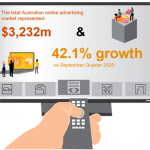Programmatic ad spend to increase by 19% next year
Some 65% of advertising money in the coming year will be traded programmatically.
According to Zenith’s Programmatic Marketing Forecasts advertisers will spend US$4 billion programmatically next year, up from US$70 billion this year, which represents 65% of digital expenditure.
By digital media we mean all forms of paid-for advertising within online content, including online video and social media, but excluding paid search and classified advertising.
The breadth of ad formats available through programmatic trading is improving, with more mobile, video and audio formats coming online all the time, though brands and agencies need to do more to push publishers to improve the quality of their inventory.
Growth in programmatic advertising is slowing as it cements its position as the most important method of digital trading.
Zenith estimates that programmatic adspend will grow 24 per cent in 2018, down from 32 per cent growth in 2017, and forecast 19 per cent growth in 2019, followed by 17 per cent growth in 2020.
In dollar terms, the biggest programmatic market is the US, where Zenith expects US$40.6bn to be spent programmatically in 2018 – 58 per cent of the total. China comes in second spending US$7.9bn on programmatic advertising this year, followed by the UK, with US$5.6bn of programmatic adspend.
The US market most embraced programmatic advertising, trading 83 per cent of all digital media programmatically this year.
Canada is in second place, trading 82 per cent of digital media programmatically, followed by the UK, with 76 per cent, and Denmark, with 75 per cent. By 2020, programmatic advertising will account for more than 80 per cent of digital media in all four markets. Canada will have almost completed the transition to pure programmatic trading, spending 99 per cent of digital media programmatically that year.
Zenith expects all markets to follow Canada and use programmatic trading for all digital media transactions eventually.
Programmatic digital advertising refers to the use of software to purchase digital advertising, as opposed to the traditional process that involves RFPs, human negotiations and manual insertion orders. It’s using machines to buy ads, basically, it’s only a matter of time before programmatic trading becomes the default method of trading for all media.
However, the transition is taking slightly longer than we expected – last year we forecast that 64 per cent of digital media would be programmatic in 2018, and 67 per cent would be programmatic in 2019, so Zenith has pulled back both forecasts by two percentage points.
The introduction of privacy legislation such as the EU’s GDPR has had some chilling effect by making certain data previously used in programmatic transactions unavailable, and making other data more costly to process. But we think the main reason for the slowdown in spending on programmatic media is that advertisers are investing more in infrastructure and data to make their programmatic activity more effective.
To make the most of their programmatic campaigns, advertisers have to re-organise internally to give programmatic trading the high-level of support and understanding it needs.
Agencies can only extract maximum effectiveness from their programmatic strategy in a proper partnership with their clients. And a programmatic strategy can only ever be as effective as the data used to execute it.
“Programmatic trading improves efficiency and effectiveness, and is gaining a dominant share of digital media transactions,” said Benoit Cacheux, Zenith’s Global Head of Digital and Innovation.
The most valuable data is first-party data, either explicitly provided by consumers or gained by tracking their activity on owned websites.
It is also becoming more common to use second-party data, by forming data sharing partnerships, between – for example – brands and online retailers.
Third-party data is widely available but does not give advertisers a competitive advantage, since all advertising can use it to target the same segments.
Advertisers should continually vet and interrogate third-party data to ensure they are truly adding incremental reach.
By combining all this data with their own CRM systems, advertisers can model consumer behaviour, and the more advanced are using machines learning to predict it. Data and new technology are enabling brands to move from tracking cookies to communicating with individuals.
“Technology is making programmatic advertising work harder for brands,” said Jonathan Barnard, Zenith’s Head of Forecasting and Director of Global Intelligence. “Artificial intelligence promises to unlock new understanding of customers as people, as well as improving the optimisation of the trading process.”
MARKETING Magazine is not responsible for the content of external sites.
An afternoon of conversations we never had, with leaders most of you never met.
Discover what’s possible from those who made it possible. Plus a preview of The HAM Agency Rankings REPORT 2024.
Limited seats: [email protected]
BOOK SEATS NOW









